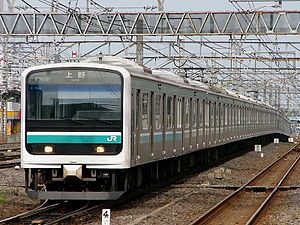E501 series
| E501 series | |
|---|---|

A 10+5-car E501 series formation on a Joban Line service, April 2003
|
|
| In service | December 1995–Present |
| Manufacturer | Kawasaki Heavy Industries, Tokyu Car Corporation |
| Constructed | 1995–1997 |
| Refurbishment | 2011–2012 |
| Number built | 60 vehicles |
| Number in service | 60 vehicles (8 sets) |
| Formation | 5/10 cars per trainset |
| Fleet numbers | K701–K704, K751–K754 |
| Operator(s) | JR East |
| Depot(s) | Katsuta |
| Line(s) served | Joban Line, Mito Line |
| Specifications | |
| Car body construction | Stainless steel |
| Car length | 20,420 mm (67 ft 0 in) (end cars) 20,000 mm (65 ft 7 in) (intermediate cars) |
| Width | 2,890 mm (9 ft 6 in) |
| Doors | 4 pairs per side |
| Maximum speed | 120 km/h (75 mph) |
| Traction system | Current: IGBT-VVVF (Toshiba) Original: GTO-VVVF (Siemens) |
| Power output | 120 kW per motor |
| Electric system(s) | 1,500 V DC / 20 kV AC (50 Hz) |
| Current collection method | Overhead catenary |
| Safety system(s) | ATS-PS |
| Track gauge | 1,067 mm (3 ft 6 in) |
The E501 series (E501系?) is an AC/DC dual-voltage (1,500 V DC / 20 kV AC 50 Hz) electric multiple unit (EMU) train type operated on local services by East Japan Railway Company (JR East) in Japan since December 1995.
Built jointly by Kawasaki Heavy Industries and Tokyu Car, the design is derived from the 209 series commuter EMU, and were initially operated as 10+5-car formations on Joban Line services out of Ueno in Tokyo, but were modified with the addition of toilets and transferred to Joban Line and Mito Line local services in the Mito area from March 2007.
As of 1 April 2014, the fleet consists of four 10-car sets, numbered K701 to K704, and four 5-car sets, numbered K751 to K754. All are based at Katsuta Depot, and are formed as shown below with car 1 at the southern end.
The four 10-car sets are formed as shown below, with four motored ("M") cars and six unpowered trailer ("T") cars.
The four 5-car sets are formed as shown below, with two motored ("M") cars and three unpowered trailer ("T") cars.
Interior view, January 2007
The first 10+5-car train was originally scheduled to be delivered in time for entry into service from the March 1995 timetable revision, but deliveries from Kawasaki Heavy Industries in Kobe were delayed until May due to the effects of the Great Hanshin earthquake in January of that year. The first trains ultimately entered revenue service from the start of the 1 December 1995 timetable revision.
Between September and October 2006, modifications were made to the side windows to allow some windows to be opened. From October 2006, the fleet underwent modifications to add toilets, and from the start of the 18 March 2007 timetable revision, the E501 series trains were displaced from Joban Line services out of Ueno by E531 series sets, and were transferred to local services on the Joban Line north of Tsuchiura and on the Mito Line. Between 2011 and 2012, the fleet underwent a life-extension refurbishment programme, which involved replacing electrical and brake equipment.
...
Wikipedia
